No edit summary |
|||
| (17 intermediate revisions by the same user not shown) | |||
| Line 1: | Line 1: | ||
AMIBIOS is | '''AMIBIOS,''' commonly stylized as '''AMI BIOS''', is an IBM PC-compatible BIOS firmware. It was initially released by [[Access Methods Inc.]] in 1985 and later acquired and developed by [[American Megatrends]] (now AMI Inc.). It is also one of the first IBM PC-compatible BIOS firmware that were mass licensed for clone systems, released shortly after the competing [[PhoenixBIOS]]. Similar to that, it was also reverse engineered under a clean room solution to avoid infringement of IBM's copyright. | ||
Its latest mainstream version, [[AMIBIOS 8]], was phased out on most platforms released after 2010, in favor of modern UEFI-based firmware solutions (such as its successor [[AMI Aptio]] or the competing [[InsydeH2O]]). Despite this, it is still used on some industrial systems (such as the ones with the [[wikipedia:Vortex86|Vortex86]] SoC) that are based on a legacy architecture. It is also commonly used on newer motherboards made for legacy platforms, especially [[wikipedia:LGA_775|LGA 775]] and [[wikipedia:LGA_1156|1156]] sockets. | |||
== | Earlier instances of [[AMI Aptio]] contained an embedded version of [[AMIBIOS 8]] as a component module for legacy boot (CSM) only mode (not to be confused with UEFI boot mode with CSM). However, since CSM was discontinued by Intel in 2020<ref>https://www.intel.com/content/www/us/en/content-details/630266/removal-of-legacy-boot-support-for-intel-platforms-technical-advisory.html | Note: Although this document was published in 2023, it clearly mentions legacy boot being discontinued in 2020.</ref>, this mode was removed along with its module. Although most newer instances still support UEFI boot mode with CSM support, this mode does not utilize the mentioned module. | ||
== Acquisition from Access Methods Inc. == | |||
''Main page: [[American Megatrends]]'' | ''Main page: [[American Megatrends]]'' | ||
Access Methods Inc. | Access Methods Inc., a joint venture by Subromanian Shankar and Pat Sarma, released the first version of AMIBIOS in 1985.<ref>https://twit.tv/shows/triangulation/episodes/226</ref> Shortly after and due to legal issues, the owners found a new company with the funds raised by this joint venture. This venture was founded as Quintessential Consultants Inc. (QCI) and later renamed to American Megatrends Inc. (AMI) to keep the "AMIBIOS" acronym. The venture then acquired AMIBIOS from Access Methods next year.<ref>https://www.youtube.com/watch?v=5jYX3sL08Xs</ref> | ||
== List of known versions == | == List of known versions == | ||
All versions | All versions before [[AMI Plus BIOS]] were initially released by Access Methods. Therefore, on most instances (ROMs) for these versions, the copyright strings mention "Access Methods Inc.". However, some of these versions were later continued to be developed by American Megatrends after the acquisition. Therefore, on these newer instances, the strings may sometimes mention "American Megatrends Inc." instead, despite not being initially released by them. | ||
In most cases, the ROMs of all versions from [[AMIBIOS 2.2x|AMIBIOS 2.x]] to [[AMIBIOS 6]] and also [[AMIBIOS 7|AMIBIOS 7 (07.00.10)]] can be identified by the six-digit date shown in the identification string, which is displayed during the Power-On Self Test (POST). This is because these dates are actually fixed to the initial release date of the AMIBIOS version. However, occasionally, some [[wikipedia:Original_equipment_manufacturer|OEMs]] modified these dates to reflect the ROM compile or release date instead, especially on early versions before [[AMI WinBIOS|AMI WinBIOS (AMIBIOS 4)]]. The ROMs for [[AMIBIOS 07.00.xx|AMIBIOS 07.00.xx (07.00.00)]] and [[AMIBIOS 8]] also cannot be identified this way, as the date in their strings is actually fixed to the ROM compile date instead of the AMIBIOS version release date. | |||
''' | '''Please note that the following information may not be fully correct for versions released before AMI Hi-Flex BIOS, as their names had to be assumed due to lack of information and other references.''' | ||
{| class="wikitable" style="width:100;%" | {| class="wikitable" style="width:100;%" | ||
!Version name | !Version name | ||
!First release date | !First release date | ||
!POST screen (if available) | !POST screen (if available) | ||
!Known core dates | |||
!Notes | !Notes | ||
|- | |- | ||
|[[AMIBIOS | |[[AMIBIOS 1.x]] | ||
| | |1985 | ||
| | |''Not available'' | ||
| | | | ||
|The first version of AMIBIOS | |||
|- | |- | ||
|[[AMIBIOS 2. | |[[AMIBIOS 2.x]] | ||
|1986 | |1986 | ||
|[[File:AMIBIOS_2.2x_POST.png|300px]] | |[[File:AMIBIOS_2.2x_POST.png|300px]] | ||
|The name is assumed based on unofficial | | | ||
|The name is assumed based on information from the unofficial MR BIOS website<ref>https://mrbios.com/techsupport/award/postcodes.htm | "AMI BIOS 2.2x" section</ref> | |||
|- | |- | ||
|[[AMI Plus BIOS | |[[AMI Plus BIOS]] | ||
|1987 | |1987 | ||
|[[File:AMI_Plus_BIOS_POST.png|300px]] | |[[File:AMI_Plus_BIOS_POST.png|300px]] | ||
| | | | ||
|Name assumed based on information from the unofficial MR BIOS website<ref>https://mrbios.com/techsupport/award/postcodes.htm | "AMI Plus BIOS" section</ref>. Commonly nicknamed "AMI Pre-Color BIOS" due to its monochrome setup utility, which is the predecessor of [[AMI Hi-Flex BIOS|Hi-Flex BIOS']] setup utility (which is in color). | |||
|- | |- | ||
|[[AMI Hi-Flex BIOS]] | |[[AMI Hi-Flex BIOS]] | ||
|1990 | |November 1990 | ||
|[[File:AMI_Hi-Flex_BIOS_POST.png|300px]] | |[[File:AMI_Hi-Flex_BIOS_POST.png|300px]] | ||
|Not to be confused with the Hi-Flex Setup Utility | | | ||
|Not to be confused with the Hi-Flex Setup Utility in [[AMIBIOS 6]] and [[AMIBIOS 07.00.10]]. Commonly nicknamed "AMI Color BIOS" or "AMIBIOS Color" due to its colorful setup utility. Possibly also called AMIBIOS 3 internally, although unconfirmed. | |||
|- | |- | ||
|[[AMI WinBIOS|AMI WinBIOS (AMIBIOS 4)]] | |[[AMI WinBIOS|AMI WinBIOS (AMIBIOS 4)]] | ||
|1993 | |December 1993 | ||
|[[File:WinBIOS_POST_screen.png|300px]] | |[[File:WinBIOS_POST_screen.png|300px]] | ||
| | | | ||
|Not to be confused with the WinBIOS Setup Utility in [[AMIBIOS 6]] | |||
|- | |- | ||
|[[AMIBIOS 5]] | |[[AMIBIOS 5]] | ||
|1994 | |October 1994 | ||
|[[File:AMIBIOS 5 101094.png|300px]] | |[[File:AMIBIOS 5 101094.png|300px]] | ||
| | |10/10/94 | ||
| | |||
|- | |- | ||
|[[AMIBIOS 6]] | |[[AMIBIOS 6]] | ||
|1995 | |July 1995 | ||
|[[File:AMIBIOS 6 POST screen.png|300px]] | |[[File:AMIBIOS 6 POST screen.png|300px]] | ||
| | |07/15/95 | ||
07/15/97 | |||
07/15/99 | |||
|Also known as AMIBIOS 97 (1997), AMIBIOS 98 (1998) and AMIBIOS 99 (1999)<ref>https://web.archive.org/web/19970623225759/http://www.amibios.com/amibios.html</ref><ref>https://web.archive.org/web/19991012065711fw_/http://ami.com/amibios/bios.platforms.desktop.html</ref> | |||
|- | |- | ||
|[[AMIBIOS 07.00.xx|AMIBIOS 07.00.xx (07.00.00)]] | |||
|[[AMIBIOS 07.00.xx|AMIBIOS 07.00.xx | |||
|1999 | |1999 | ||
|[[File:AMIBIOS 07.00.xx POST.png|300px]] | |[[File:AMIBIOS 07.00.xx POST.png|300px]] | ||
|Not to be confused with AMIBIOS 07.00.10 | |''Not used'' | ||
|Officially named AMIBIOS V7.0<ref>https://web.archive.org/web/20000607010157fw_/http://www.ami.com/y2k_ami.html | "V.7.0" is listed as an AMIBIOS version, which must be 07.00.xx as 07.00.10 was not yet released at the time</ref>, not to be confused with [[AMIBIOS 7|AMIBIOS 7 (07.00.10)]]. Likely a pre-release version of [[AMIBIOS 8|AMIBIOS 8 (BigBIOS)]]. | |||
|- | |- | ||
| | |[[AMIBIOS 7|AMIBIOS 7 (07.00.10)]] | ||
|April 2001 | |||
|2001 | |||
|[[File:AMIBIOS 07.00.10 POST.png|300px]] | |[[File:AMIBIOS 07.00.10 POST.png|300px]] | ||
| | |04/02/01 | ||
|Also named AMIBIOS 07.00T. Possibly an update for AMIBIOS 6 for meeting the [[wikipedia:PC_System_Design_Guide#PC_2001|PC 2001]] requirements. | |||
|2001 | |||
|- | |- | ||
|[[AMIBIOS 8]] | |[[AMIBIOS 8]] | ||
|2001 | |October 2001 | ||
|[[File:AMIBIOS 8 POST screen (large logo).png|300px]] | |[[File:AMIBIOS 8 POST screen (large logo).png|300px]] | ||
|''Not used'' | |||
|Last commercial version of AMIBIOS. Codenamed "BigBIOS". | |||
|''Not | |||
| | |||
|- | |- | ||
|[[AMIBIOS 9]] | |[[AMIBIOS 9]] | ||
|''Unknown'' | |''Unknown'' | ||
|''Not available.'' | |''Not available.'' | ||
|Used | |''Not used'' | ||
|Used in Microsoft Hyper-V. Possibly the name given to the BIOS emulation component for CSM/legacy only mode in [[AMI Aptio]]. | |||
|} | |} | ||
== | == ROM identification string == | ||
The | The ROM identification string was first introduced with [[AMIBIOS 2.x]] and is often located at the bottom left of the POST screen. With this string, many useful details regarding the BIOS ROM can usually be gathered, such as the ROM size, chipset, motherboard manufacturer and sometimes even the AMIBIOS version. The string is formatted into sections with each containing different information regarding the ROM. The known codes for these sections are listed in [[Document:AMIBIOS string codes|the list of codes for BIOS strings]] (also available at the bottom of this page). The string format has been changed various times with some new releases of AMIBIOS. | ||
=== AMIBIOS 2. | === AMIBIOS 2.x === | ||
<code>MMMM-SSSSSS</code> | |||
* '''MMMM:''' OEM identification code | |||
* '''SSSSSS:''' AMIBIOS version release date (occasionally modified to reflect the ROM compile date instead) | |||
'''Example string''': 1406-061286 | '''Example string''': 1406-061286 | ||
This string is for | This string is for an AMIBIOS 2.x version released on June 12, 1986 ("061286") for Flying Triumph Co. Ltd. ("1406"). | ||
=== AMI Plus BIOS === | === AMI Plus BIOS === | ||
<code>DCCC-MMMM-SSSSSS-KK</code> (single digit CMOS setup type) | |||
<code> | <code>DDCCC-MMMM-SSSSSS-KK</code> (two digit CMOS setup type) | ||
''' | * '''D:''' CMOS setup type | ||
** This section can also be two characters long for "DE" if the ROM contains both built-in diagnostics and an extended setup. | |||
* '''CCC:''' Chipset type | |||
* '''MMMM:''' OEM identification code | |||
* '''SSSSSS:''' AMIBIOS version release date (occasionally modified to reflect the ROM compile date instead) | |||
* '''KK:''' Keyboard controller ID (with second character indicating the model). | |||
'''Example string''': D286-1277-043089-K0 | '''Example string''': D286-1277-043089-K0 | ||
This string is for | This string is for an AMI Plus BIOS version released on April 30, 1986 ("043089") with built-in diagnostics ("D") for a machine with a discrete logic chipset for [[wikipedia:Intel_80286|80286]] ("286") and a default/unknown keyboard controller (K"0") for Trangg Bow Co. ("1277"). | ||
=== AMI Hi-Flex BIOS and later versions === | |||
This format is also used by the earlier instances of [[AMI Aptio]] with the CSM module. | |||
<code>CR-VVVV-00MMMM-FFFFFFFF-SSSSSS-DDDDDDDD-Project-Y2KC-K</code> | |||
* '''C:''' Processor architecture | |||
'''C:''' Processor architecture | * '''R:''' ROM size | ||
* '''MMMM:''' OEM identification code | |||
* '''FFFFFFFF:''' BIOS feature identification | |||
** Usually "00101111" which is the default. | |||
* '''SSSSSS:''' ROM compile date ([[AMIBIOS 07.00.xx]] and [[AMIBIOS 8]]) or the AMIBIOS version release date (all other versions, excluding OEM modifications) | |||
** '''Note:''' Even on versions using the initial release date, this section was occasionally modified by the OEM to reflect the ROM release date instead. | |||
* '''DDDDDDDD:''' BIOS identifier (usually the chipset) | |||
* '''Project:''' Internal BIOS project ID | |||
** Only used on later revisions of [[AMIBIOS 6]] and later versions. | |||
* '''Y2KC:''' Most likely an indicator for Year 2000 (Y2K) compatibility | |||
** Only used on [[AMIBIOS 07.00.xx]] and [[AMIBIOS 8|8]]. | |||
* '''K:''' Keyboard controller ID | |||
** Not used on [[AMIBIOS 7|AMIBIOS 7 (07.00.10)]] and [[AMIBIOS 8|8]]. | |||
''' | '''Example string''': 61-0530-001169-00101111-071595-440BX/ZX-1AAET006-R | ||
This string is for a 05.30 version ("0530") 128 KB ("1")* size AMIBIOS 6 ROM ("071595", initial release date for AMIBIOS 6) for 686 architecture processors ("6") with Intel 440BX or ZX chipset ("440BX/ZX") and an AMIKEY '94 clone keyboard controller ("R") for project ID 1AAET006 of MSI ("1169"). | |||
This string is | <nowiki>*</nowiki> The BIOS ROM size is actually 256 KB in this specific case, the 128 KB size specified in the string is erroneous. This also proves that the string is not always fully accurate.. | ||
=== List of known codes for | === List of known codes for sections of the ROM identification string === | ||
<div class="toccolours mw-collapsible mw-collapsed"> | <div class="toccolours mw-collapsible mw-collapsed"> | ||
Click "Expand" to view. | Click "Expand" to view. | ||
Latest revision as of 07:49, 19 March 2025
AMIBIOS, commonly stylized as AMI BIOS, is an IBM PC-compatible BIOS firmware. It was initially released by Access Methods Inc. in 1985 and later acquired and developed by American Megatrends (now AMI Inc.). It is also one of the first IBM PC-compatible BIOS firmware that were mass licensed for clone systems, released shortly after the competing PhoenixBIOS. Similar to that, it was also reverse engineered under a clean room solution to avoid infringement of IBM's copyright.
Its latest mainstream version, AMIBIOS 8, was phased out on most platforms released after 2010, in favor of modern UEFI-based firmware solutions (such as its successor AMI Aptio or the competing InsydeH2O). Despite this, it is still used on some industrial systems (such as the ones with the Vortex86 SoC) that are based on a legacy architecture. It is also commonly used on newer motherboards made for legacy platforms, especially LGA 775 and 1156 sockets.
Earlier instances of AMI Aptio contained an embedded version of AMIBIOS 8 as a component module for legacy boot (CSM) only mode (not to be confused with UEFI boot mode with CSM). However, since CSM was discontinued by Intel in 2020[1], this mode was removed along with its module. Although most newer instances still support UEFI boot mode with CSM support, this mode does not utilize the mentioned module.
Acquisition from Access Methods Inc.
Main page: American Megatrends
Access Methods Inc., a joint venture by Subromanian Shankar and Pat Sarma, released the first version of AMIBIOS in 1985.[2] Shortly after and due to legal issues, the owners found a new company with the funds raised by this joint venture. This venture was founded as Quintessential Consultants Inc. (QCI) and later renamed to American Megatrends Inc. (AMI) to keep the "AMIBIOS" acronym. The venture then acquired AMIBIOS from Access Methods next year.[3]
List of known versions
All versions before AMI Plus BIOS were initially released by Access Methods. Therefore, on most instances (ROMs) for these versions, the copyright strings mention "Access Methods Inc.". However, some of these versions were later continued to be developed by American Megatrends after the acquisition. Therefore, on these newer instances, the strings may sometimes mention "American Megatrends Inc." instead, despite not being initially released by them.
In most cases, the ROMs of all versions from AMIBIOS 2.x to AMIBIOS 6 and also AMIBIOS 7 (07.00.10) can be identified by the six-digit date shown in the identification string, which is displayed during the Power-On Self Test (POST). This is because these dates are actually fixed to the initial release date of the AMIBIOS version. However, occasionally, some OEMs modified these dates to reflect the ROM compile or release date instead, especially on early versions before AMI WinBIOS (AMIBIOS 4). The ROMs for AMIBIOS 07.00.xx (07.00.00) and AMIBIOS 8 also cannot be identified this way, as the date in their strings is actually fixed to the ROM compile date instead of the AMIBIOS version release date.
Please note that the following information may not be fully correct for versions released before AMI Hi-Flex BIOS, as their names had to be assumed due to lack of information and other references.
| Version name | First release date | POST screen (if available) | Known core dates | Notes |
|---|---|---|---|---|
| AMIBIOS 1.x | 1985 | Not available | The first version of AMIBIOS | |
| AMIBIOS 2.x | 1986 | 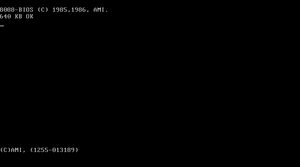
|
The name is assumed based on information from the unofficial MR BIOS website[4] | |
| AMI Plus BIOS | 1987 | 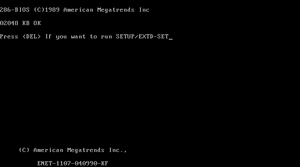
|
Name assumed based on information from the unofficial MR BIOS website[5]. Commonly nicknamed "AMI Pre-Color BIOS" due to its monochrome setup utility, which is the predecessor of Hi-Flex BIOS' setup utility (which is in color). | |
| AMI Hi-Flex BIOS | November 1990 | 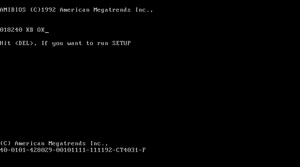
|
Not to be confused with the Hi-Flex Setup Utility in AMIBIOS 6 and AMIBIOS 07.00.10. Commonly nicknamed "AMI Color BIOS" or "AMIBIOS Color" due to its colorful setup utility. Possibly also called AMIBIOS 3 internally, although unconfirmed. | |
| AMI WinBIOS (AMIBIOS 4) | December 1993 | 
|
Not to be confused with the WinBIOS Setup Utility in AMIBIOS 6 | |
| AMIBIOS 5 | October 1994 | 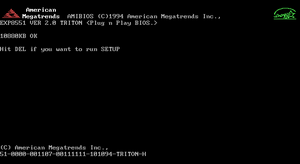
|
10/10/94 | |
| AMIBIOS 6 | July 1995 | 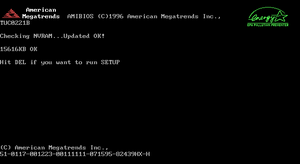
|
07/15/95
07/15/97 07/15/99 |
Also known as AMIBIOS 97 (1997), AMIBIOS 98 (1998) and AMIBIOS 99 (1999)[6][7] |
| AMIBIOS 07.00.xx (07.00.00) | 1999 | 
|
Not used | Officially named AMIBIOS V7.0[8], not to be confused with AMIBIOS 7 (07.00.10). Likely a pre-release version of AMIBIOS 8 (BigBIOS). |
| AMIBIOS 7 (07.00.10) | April 2001 | 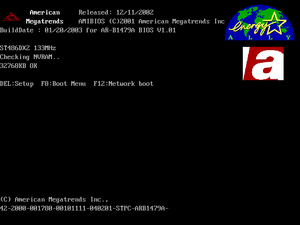
|
04/02/01 | Also named AMIBIOS 07.00T. Possibly an update for AMIBIOS 6 for meeting the PC 2001 requirements. |
| AMIBIOS 8 | October 2001 | 
|
Not used | Last commercial version of AMIBIOS. Codenamed "BigBIOS". |
| AMIBIOS 9 | Unknown | Not available. | Not used | Used in Microsoft Hyper-V. Possibly the name given to the BIOS emulation component for CSM/legacy only mode in AMI Aptio. |
ROM identification string
The ROM identification string was first introduced with AMIBIOS 2.x and is often located at the bottom left of the POST screen. With this string, many useful details regarding the BIOS ROM can usually be gathered, such as the ROM size, chipset, motherboard manufacturer and sometimes even the AMIBIOS version. The string is formatted into sections with each containing different information regarding the ROM. The known codes for these sections are listed in the list of codes for BIOS strings (also available at the bottom of this page). The string format has been changed various times with some new releases of AMIBIOS.
AMIBIOS 2.x
MMMM-SSSSSS
- MMMM: OEM identification code
- SSSSSS: AMIBIOS version release date (occasionally modified to reflect the ROM compile date instead)
Example string: 1406-061286
This string is for an AMIBIOS 2.x version released on June 12, 1986 ("061286") for Flying Triumph Co. Ltd. ("1406").
AMI Plus BIOS
DCCC-MMMM-SSSSSS-KK (single digit CMOS setup type)
DDCCC-MMMM-SSSSSS-KK (two digit CMOS setup type)
- D: CMOS setup type
- This section can also be two characters long for "DE" if the ROM contains both built-in diagnostics and an extended setup.
- CCC: Chipset type
- MMMM: OEM identification code
- SSSSSS: AMIBIOS version release date (occasionally modified to reflect the ROM compile date instead)
- KK: Keyboard controller ID (with second character indicating the model).
Example string: D286-1277-043089-K0
This string is for an AMI Plus BIOS version released on April 30, 1986 ("043089") with built-in diagnostics ("D") for a machine with a discrete logic chipset for 80286 ("286") and a default/unknown keyboard controller (K"0") for Trangg Bow Co. ("1277").
AMI Hi-Flex BIOS and later versions
This format is also used by the earlier instances of AMI Aptio with the CSM module.
CR-VVVV-00MMMM-FFFFFFFF-SSSSSS-DDDDDDDD-Project-Y2KC-K
- C: Processor architecture
- R: ROM size
- MMMM: OEM identification code
- FFFFFFFF: BIOS feature identification
- Usually "00101111" which is the default.
- SSSSSS: ROM compile date (AMIBIOS 07.00.xx and AMIBIOS 8) or the AMIBIOS version release date (all other versions, excluding OEM modifications)
- Note: Even on versions using the initial release date, this section was occasionally modified by the OEM to reflect the ROM release date instead.
- DDDDDDDD: BIOS identifier (usually the chipset)
- Project: Internal BIOS project ID
- Only used on later revisions of AMIBIOS 6 and later versions.
- Y2KC: Most likely an indicator for Year 2000 (Y2K) compatibility
- Only used on AMIBIOS 07.00.xx and 8.
- K: Keyboard controller ID
- Not used on AMIBIOS 7 (07.00.10) and 8.
Example string: 61-0530-001169-00101111-071595-440BX/ZX-1AAET006-R
This string is for a 05.30 version ("0530") 128 KB ("1")* size AMIBIOS 6 ROM ("071595", initial release date for AMIBIOS 6) for 686 architecture processors ("6") with Intel 440BX or ZX chipset ("440BX/ZX") and an AMIKEY '94 clone keyboard controller ("R") for project ID 1AAET006 of MSI ("1169").
* The BIOS ROM size is actually 256 KB in this specific case, the 128 KB size specified in the string is erroneous. This also proves that the string is not always fully accurate..
List of known codes for sections of the ROM identification string
Click "Expand" to view.
- ↑ https://www.intel.com/content/www/us/en/content-details/630266/removal-of-legacy-boot-support-for-intel-platforms-technical-advisory.html | Note: Although this document was published in 2023, it clearly mentions legacy boot being discontinued in 2020.
- ↑ https://twit.tv/shows/triangulation/episodes/226
- ↑ https://www.youtube.com/watch?v=5jYX3sL08Xs
- ↑ https://mrbios.com/techsupport/award/postcodes.htm | "AMI BIOS 2.2x" section
- ↑ https://mrbios.com/techsupport/award/postcodes.htm | "AMI Plus BIOS" section
- ↑ https://web.archive.org/web/19970623225759/http://www.amibios.com/amibios.html
- ↑ https://web.archive.org/web/19991012065711fw_/http://ami.com/amibios/bios.platforms.desktop.html
- ↑ https://web.archive.org/web/20000607010157fw_/http://www.ami.com/y2k_ami.html | "V.7.0" is listed as an AMIBIOS version, which must be 07.00.xx as 07.00.10 was not yet released at the time